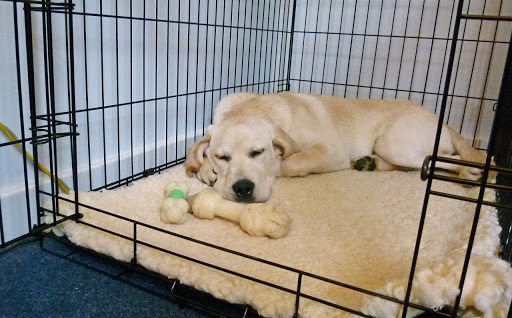Bringing a pup home is such a delight, but what is one to do when we are away at work or have to go to a party or are busy with some task? One option is to leave the dog in the house, knowing well that he will chew and rip things and poop all over the place. The other option is to put him in a crate, make him comfortable, and go about our work knowing that both the pup and the house are safe. It might sound a bit cruel, but crater training is an important part of Labrador training.

Get the crate ready before you bring your Labrador home. Once it moves around the house, encourage it to start exploring the crate. Entice him with a doggy treat. At first you might have to coerce him inside the crate, so let him look around. Don’t close the door when he does go in the crate; instead, praise him for getting in and let him wander in and out.
Do this several times. Once he seems comfortable with the crate, shut the door for a few minutes once he is in. He will start whining, but don’t open it immediately. Talk through the mesh, tickle or pet him, and once he is calm, open the door. Keep doing this several times so that he is no longer afraid of being shut in.
Never use the crate for punishment. He should realize that the crate is a space of comfort. Once he settles down in the crate, reinforce the idea that once he is out of the crate, he needs to do his ‘job’. Take him out so that he can relieve himself.
It is also necessary to decide what kind of crate you should buy and what is the ideal size. Crates are available in both wire mesh and plastic varieties. Airlines allow only plastic crates for transportation. For home use, you can use both. The crate should be big enough for your Labrador to stand up and move around comfortably.
Why go through the unnecessary expenditure of buying different sizes as your pup keeps growing? Buy one for a full grown dog and close off the remaining space with a piece of cardboard if you wish, making adjustments as your pup grows. The reason for this is that dogs don’t poop in the place they sleep in. So if the crate is big, your pup might soil one corner and sleep in another corner.
Your pet needs to be taught bowel control, so too much space is not advisable. Labrador training is all inclusive. Make your pup comfortable with an old blanket and some chew toys. Try not to use new or fancy bedding, as dogs chew on anything they find, so there is no use ruining expensive bedding.
Crate training is important for Labrador and Retriever training, but you should be considerate while using the crate. It is a place to keep them safe and comfortable, and not a place where you keep them in for hours while you go about your work. When the Lab is 8-10 weeks old, he should be kept in the crate for only 2-3 hours. At the age of 12-16 weeks, he can be kept up to 4 hours.
At no age should the dog be shut in for more than 6 hours. It needs to relieve itself after all, and if you are personally unable to take him out, let someone else do it. It should not be an uncomfortable experience for him which he would come to resent. A crate should be a dog’s personal space for napping and resting, and the children should also be taught not to disturb him while he is in the crate.